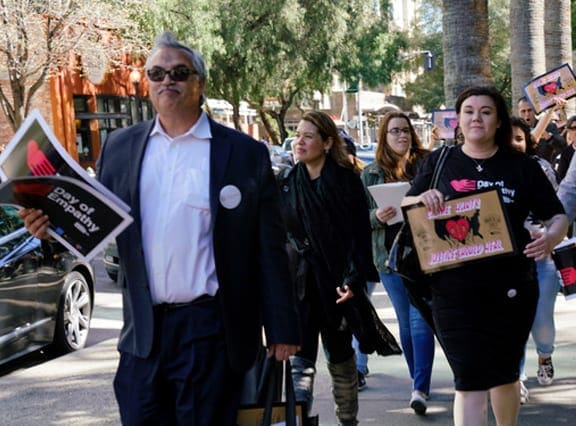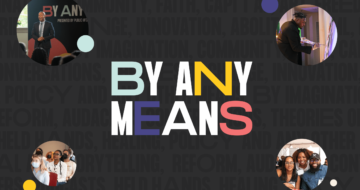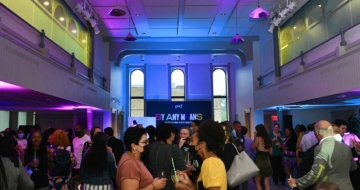Hilda recalled that her son said he felt like a toy that was broken and thrown in the trash. No one wanted to fix him. Faced with spending the rest of his life in prison, “He said we should go on with our lives and forget about him, and I said, ‘No!’”
Nora’s son was killed at a neighborhood convenience store. She remembered going to the hospital and being taken to the chapel where her daughter, who was there already, told her that Nicholas was dead. “I remember hearing a scream and I didn’t know where it was coming from, and it was me.”
Hilda and Nora were brought together in a recently released video by Healing Dialogue and Action, a Public Welfare Foundation grantee that helps families that have lost children to homicide and those that have lost children to incarceration come together to find peace and healing.
It is especially difficult to see a child disappear behind bars for life for a crime—however heinous—that was committed when he or she was as young as 14. That has happened in California, especially since the passage of Proposition 21 in 2001, which increased a number of criminal penalties for crimes committed by youth and sent many more youth into the adult criminal justice system.
Five years after Proposition 21 had passed, juvenile justice reform advocates felt it had become so entrenched—with another ballot initiative or a two-thirds majority in the Legislature needed to overturn or change it—that they were frustrated by their seeming inability to keep youths from being transferred to adult courts.
“It was just not politically feasible,” recalled Elizabeth Calvin, senior advocate in the Children’s Rights Division at Human Rights Watch in Los Angeles, another Public Welfare Foundation grantee. “So, we kind of took a step back and ultimately decided to work on the issue of life without parole.”
By that time in 2006, the U.S. Supreme Court had ruled that it was unconstitutional to impose the death penalty for crimes committed before the age of 18, citing a lack of maturity and responsibility among youth compared to adults. In 2005, Human Rights Watch issued a comprehensive report about the use of life without parole for people under the age of 18 in the United States and it became a rallying point for advocates.
For Calvin and other juvenile advocates, all of the bad consequences they feared for youth transferred to the adult system applied to youth sentenced to life without parole.
“[We] felt that life without parole was the most extreme, the worst outcome for a young person transferred to the adult system,” Calvin recalled. “And I believed that if we started talking about California’s use of life without parole for children, and helped the public and legislators understand what that sentence really meant…we’d be talking about all of the foundational issues related to transferring youth to the adult system.”
What Calvin and other advocates thought was most important to recognize—just as the U.S. Supreme Court had begun to emphasize—was the research emerging at the time that related to adolescent brain development. In the past decade there has been growing evidence that adolescents differ from adults in key respects—including impulse control and the ability to resist peer influence—that are relevant to issues of culpability and rehabilitation.
Advocates realized that getting public officials and the public to accept the fact that even young people who committed terrible acts could change over time was critical to getting policy changes.
As Calvin put it, “The brain science [about] development, the ability of young people to turn themselves around, the importance of treating young people as precious—all of these ideas cut across concepts and values in law, religion, and child welfare. I thought of them as a Trojan horse that looked like life without parole on the outside, but inside of it were all the ideas that are central to dramatically changing the justice system as it pertains to young people, period, but certainly when it comes to the issue of transferring youth to the adult system.”
A key component of the advocacy work in California was the collaboration that developed between Human Rights Watch and Healing Dialogue and Action. Many families of homicide victims and families of incarcerated youth became united in their belief that sending youth to the adult criminal justice system or giving them sentences of life without parole were simply not appropriate.
From 2007 to 2015, these families and other advocates supported a handful of bills dealing with life without parole. But after the first couple of bills failed, in large part because of the need to secure a two-thirds vote of the Legislature, the strategy shifted to securing incremental changes. For example, one measure known as SB 9 was passed in 2012 by a majority vote.
Javier Stauring, who directs Healing Dialogue and Action, recalled “one mom whose child was murdered sitting on one side of a legislator, and a mom whose child was serving life without parole sitting on the other side of the legislator. And both moms were telling the legislator, ‘It’s wrong, wrong to do this [life without parole] to children.’”
That law took effect in 2013 and has allowed people who received sentences of life without parole for crimes committed when they were younger than 18 to petition the court for reconsideration and a parole-eligible sentence. Acceptance of the petition and the resentence is left to the discretion of the court. This historic law was the first of its type passed in the country.
Another law, passed in 2013, has allowed youth under the age of 18 who received lengthy sentences in adult prisons to go before the parole board after serving 15, 20, or 25 years. It meant that California youth who were serving extremely long sentences received an early chance to get out. Under the law, the parole board is instructed to give “great weight” to the age of the offender at the time of the crime and to recognize that youth have diminished culpability compared to adults who commit the same crime.
When that law was passed, about 6,500 people in California prisons had been under the age of 18—some had been as young as 14—when they committed their crimes and about 4,000 of them had received sentences that were long enough to make them eligible for the youth offender parole process. In 2015, another law, SB 261, extended the youth offender parole process to youth who had committed crimes between the ages of 18 to 23, making an estimated 20,000 people potentially eligible for youth offender parole.
And another law passed in 2014 limited the regular practice of the state’s Department of Corrections of putting people aged 14 through 22 at the time of their crimes into maximum security adult prison units where they would routinely face rape, assault, and pressure to work for gangs, with “just horrific, horrific results,” as Calvin noted.
However, corrections officials have embraced the new law and the vast majority—about 80 percent—of young people are now sent to lower level security prisons where they are being given access to rehabilitative programs that were not available to them before. The others have their cases reviewed within a year, and the law gives clear guidelines for moving them at that point.
Also in 2014, some progress was made on the front end of the system when a bill was passed that changed the criteria judges use to determine whether to transfer youth to the adult system. “Only 20 percent of transfer cases were decided by judges and the rest were directly filed by prosecutors,” Calvin recalled. “It almost felt like it wasn’t worth it to change the judicial criteria. But it did have an impact. And, as it turned out, it was a foot in the door to further change.”
That change came in the form of a ballot measure passed last November, Proposition 57, which ended the power of prosecutors to “direct file” youth into adult court and returned discretion to judges to decide whether a youth is tried in adult or juvenile court. Prop 57, which included other juvenile and adult criminal reforms— and was strongly supported by Foundation grantees Alliance for Safety and Justice and Californians for Safety and Justice as well as numerous justice reform groups—passed with nearly 65 percent of votes cast. And, since California is among the top two states (together with Florida) that use direct file so extensively, sending too many youth to adult courts, the voters’ decision to end the practice has national implications.
As California has progressed in its treatment of youthful offenders, the effort to help their families survive, heal, and become involved in advocating for a better system, has broken some new ground.
“[O]ur approach has always been to prioritize the healing process for the people who are most directly impacted,” explained Stauring about Healing Dialogue’s philosophy. “[But also] recognizing that, for some, this process includes getting involved in systemic reform and creating the opportunities for their stories to be heard and for their experiences to be valued.”
And, as Calvin noted, “The leadership of directly affected individuals and families has been a vital part of the entire advocacy effort. This state simply could not have accomplished as much change as it has without them in the forefront.”



